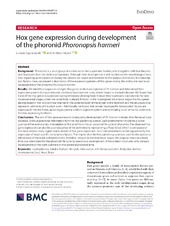| dc.description.abstract | Background: Phoronida is a small group of marine worm-like suspension feeders, which together with brachiopods and bryozoans form the clade Lophophorata. Although their development is well studied on the morphological level, data regarding gene expression during this process are scarce and restricted to the analysis of relatively few transcription factors. Here, we present a description of the expression patterns of Hox genes during the embryonic and larval development of the phoronid Phoronopsis harmeri. Results: We identified sequences of eight Hox genes in the transcriptome of Ph. harmeri and determined their expression pattern during embryonic and larval development using whole mount in situ hybridization. We found that none of the Hox genes is expressed during embryonic development. Instead their expression is initiated in the later developmental stages, when the larval body is already formed. In the investigated initial larval stages the Hox genes are expressed in the non-collinear manner in the posterior body of the larvae: in the telotroch and the structures that represent rudiments of the adult worm. Additionally, we found that certain head-specific transcription factors are expressed in the oral hood, apical organ, preoral coelom, digestive system and developing larval tentacles, anterior to the Hox-expressing territories. Conclusions: The lack of Hox gene expression during early development of Ph. harmeri indicates that the larval body develops without positional information from the Hox patterning system. Such phenomenon might be a consequence of the evolutionary intercalation of the larval form into an ancestral life cycle of phoronids. The observed Hox gene expression can also be a consequence of the actinotrocha representing a “head larva”, which is composed of the most anterior body region that is devoid of Hox gene expression. Such interpretation is further supported by the expression of head-specific transcription factors. This implies that the Hox patterning system is used for the positional information of the trunk rudiments and is, therefore, delayed to the later larval stages. We propose that a new body form was intercalated to the phoronid life cycle by precocious development of the anterior structures or by delayed development of the trunk rudiment in the ancestral phoronid larva. | en_US |

